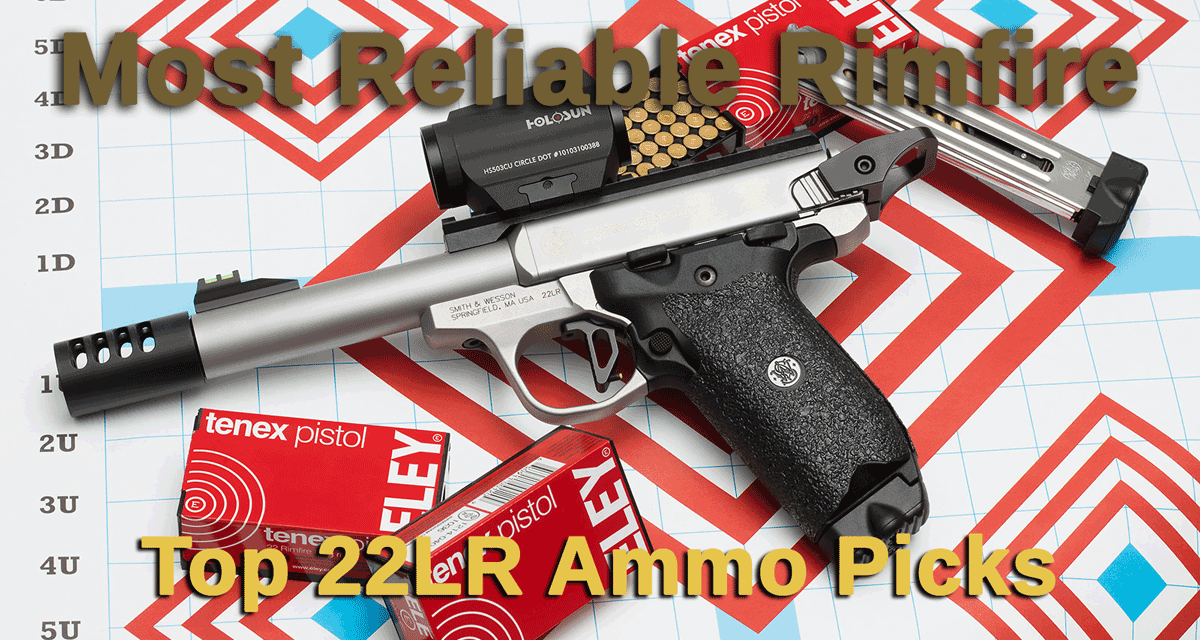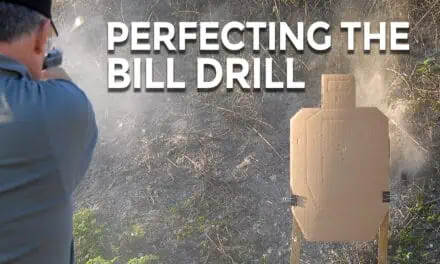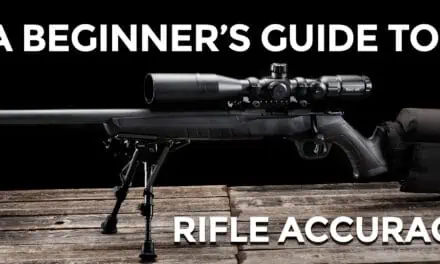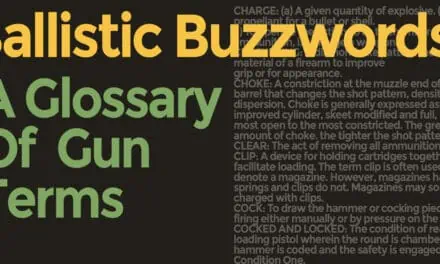22 long rifle and other rimfire calibers don’t enjoy a great reputation for reliability. However, with the right process in place when selecting your ammo, shooters can eliminate a lot of the common frustrations. In this guide, we’ll share our picks for the most reliable 22LR ammo and give you a quick cheat-sheet of factors to consider when picking rimfire ammo. Of course we recommend some trial-and-error with your specific firearm but with this guide, you’ll save money on ammo as we all as save time and frustration with your rimfire firearms.
Most Reliable 22LR Ammo
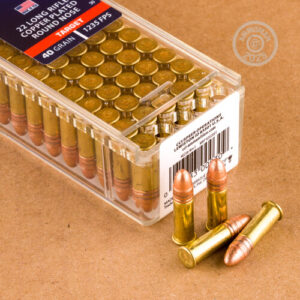 CCI 40 Grain Mini-Mag CPRN
CCI 40 Grain Mini-Mag CPRN
Simply the standard when it comes to 22 LR ammo. CCI prices their Mini-Mags competitively and have a track record of reliability. We haven’t had a single negative review of this product and have sold tons of it over the years at AmmoMan.com. Expect a muzzle velocity in the vicinity of 1235 feet per second.
You can grab a single mini-mag with 100 rounds here if you want to try it before going big with a bulk purchase.
Eley 40 Grain LRN 22LR Ammo
Eley loads their “Club” line of 22 long rifle ammo with a lead round nose bullet. That’s not the copper-plated load we generally prefer but frankly, Eley is a premium product and its reputation reliability gives us confidence to allow this wiggle room. The Club line of ammo is considered mid-tier among their competition ammo.
With this ammo, you can expect about 1085 feet per second of muzzle velocity.
Remington Golden Bullet 40 Grain CPRN 22 LR Ammo
Another classic 22LR offering, this time from Remington. This 40 grain load is a copper plated round nose option with a wonderful track record. It’s a relatively simple, no-frills, reliable option that delivers about 1250 feet per second of muzzle velocity in manufacturer testing. We offer this in both bulk and 100-round packs if you want to dip your toes in before stacking it deep.
Rimfire Reliability Issues Through History

Rimfire ammunition has been around since the 1850s. By the 1870s, it had largely passed from serious defensive use, likewise from hunting outside of small game. That had more to do with reliability issues than with power, as .44 Henry and .41 Swiss Vetterli loads were quite potent. However, both required dual firing pins to improve the probability of successful ignition. Tippmann’s modern .22 AR rifles returned to that expedient to deal with lesser quality ammunition that a lot of us use for practice. That’s because the priming material spun into the rim of rimfire cartridge isn’t always evenly distributed without voids.
For recreational plinking, lack of 22 LR reliability isn’t a deal breaker, though a definite annoyance. Failures kill a new shooter’s confidence. For competition, it’s a score-buster. Since various types of firearms are susceptible to different types of problems, let’s look at them in detail.
What Causes Rimfire Ammo to Fail?

Oversized Bullets
The first, very common issue, is the oversized bullets. Being heeled and made of soft lead, rimfire bullets often have excess material around the exposed front half. They don’t chamber easily, can shear off lead shavings if forced, causing rapid fouling of the breech face. With revolvers, they usually fail to fit the chambers with just finger pressure. With semi auto pistols and rifles they fail to chamber entirely. Since rimfire extractors aren’t intended to exert undue force on the rims, they also fail to extract when half-chambered. This means you’ll need tools to remove them. Worse, when fully chambered, they resist extraction — that’s why visual verification of chamber status is so important when unloading. Since rims are pressure sensitive, you have to knock stuck cartridges out with a cleaning rod. Oversized bullets can usually be chambered in manual actions, but extraction remains a problem. This type of cartridges can cycle autoloaders just fine when fired, as the bullet goes downrange while residual chamber pressure helps kick spent cases out of the chamber.
Primer Distribution
Uneven primer distribution is the classic rimfire problem, causing misfires. That’s less of a problem than stuck rounds, as clearing them can be part of training. However, deformed rims can cause unfired rounds to stick in the chamber, causing double feeds when immediate clearing drill is performed. This problem is more common with bulk packed ammunition: even the same exact nominal type of cartridge will likely work more reliably when sold in 50 or 100 round boxes than in bulk packs. When encountering such ammunition, try it in different guns. Some have heartier firing pin impacts than others, and are thus more likely to be reliable. Revolvers also allow going to the next cartridge without an immediate malfunction drill.
Uneven Powder Load
Uneven powder load is more of a detriment to accuracy than it is to function, especially in manual actions. However, semi autos can fail to cycle if they don’t have an excess of bolt energy to start with. Since an overly energetic bolt movement isn’t great for follow-up shots or for the longevity of the firearms, most tuned guns are more demanding of ammunition consistency than the cheaper, less refined models. Paradoxically, when such simpler guns often prove better for basic training than a tuned competition firearm. A full failure to extract is a less frequent result of a weak powder load than a stovepipe, a spent case getting caught between the bolt and the slide or the breech face. Even more typical is a situation in which the bolt goes back just enough to pick up the next round but without enough energy to chamber the next cartridge fully.
A combination of the two previous problems is the squib. That happens when the primer ignites but powder does not. It’s a rare event. In handguns, the bullet usually gets pushed out of the barrel just with the primer pressure, but can be stuck in a rifle. Squibs produce a very different, quiet and dull report and autoloading fails. In this case, it’s unlikely that a second shot would impact the stuck bullet. In a blowback semi auto, if another cartridge is chambered manually, a bulged barrel is likely, as is a ruptured cartridge case venting excess gas and brass chunks out of the ejection port. You should clear a squib with a cleaning rob, ideally from the breech side.
Bad Brass Casings
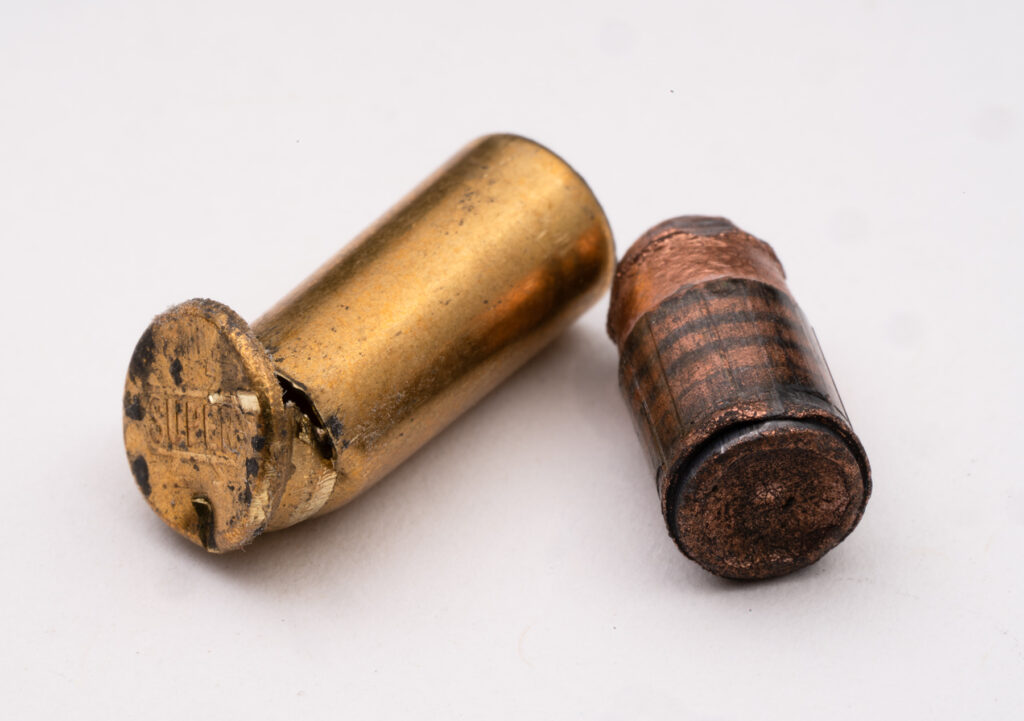
Poor quality brass, another unusual problem, causes blowout of the case rim, often adjacent to the firing pin impact. In a locked breech action, it does little harm beyond dirtying the chamber, but can cause gas blowout in a semi-auto. Remember your eye protection! A case head separation is usually a loud event.
Feeding Issues due to Build-Up
The last typical problem is poor feeding. Fouling usually causes feeding issues, unless it stems from a poorly designed firearm. The same surface lubricant that keeps rimfire bores clean can cause problems through buildup over time. Some competition shooters, such as Metal Madness participants, remove the ammo lubricant before shooting long courses of fire. This is more critical for semi-auto guns, as lubricant burns up long before manual actions can open for reloading.
How To Keep Your Rimfire Firearms Running
So, what can you do to avoid reliability problems with rimfire?
Maintenance
First, keep your guns clean and lubricated. Second, get quality ammunition. A big plus of online ammunition sources is the access to customer comments and ratings. In general, it’s worth getting several types of ammunition in the weight and velocity range desired before buying in bulk. 22LRs are sensitive to ammunition choices not just for function but also for accuracy. Once you shoot some test rounds, you will know which loads work, which do not, which of the functional ones produce good results. Once you have a ranked selection, decide which of them are worth the asking price to you. In my experience, mid-priced CCI Mini Mags have been the go to for price/performance/reliability crossover. Eley 22LR Ammo, pretty much every load, has been exemplary as well. In firearms, I found Walther PPQ .22, Henry lever actions, and base model Ruger 10-22 to be reliable even with less than ideal fodder.
Bullet Selection
Generally, copper-plated bullets cycle better in semi automatics because their harder surface resists deformation better. Often, unplated standard velocity ammunition works every bit as well in clean guns, while producing better accuracy, but the same cartridges’ lower energy level leaves less margin of reliability once firearms get dirty. Sometimes, even bulk ammunition proves reliable enough at an attractive price — just make sure to test it before an important event. For competition, it’s worth doing a visual examination of every round — some problems, like damaged brass or a mis-seated bullet, are easy to tell at a glance. Fortunately, quality control has been improving over the last several years, so we are unlikely to run into truly bad lots anymore. Still, ammunition for guns is no different than fuel for cars — is it worth saving a little to risk problems down the road?

